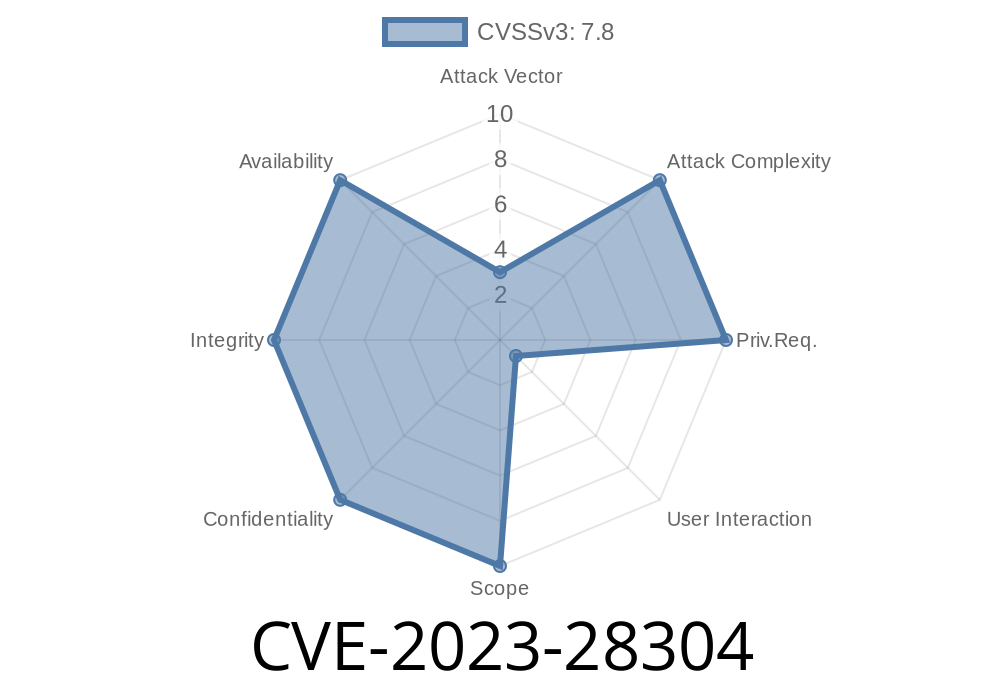In April 2023, Microsoft published CVE-2023-28304—a remote code execution (RCE) flaw that affects critical components used by millions of Windows applications: the Open Database Connectivity (ODBC) driver and Object Linking and Embedding, Database (OLE DB) provider. This exclusive, easy-to-read post explains what the vulnerability is, how it can be exploited, and includes proof-of-concept code snippets to help you understand the risk.
What Is CVE-2023-28304?
CVE-2023-28304 is a remote code execution (RCE) vulnerability found in Microsoft ODBC and OLE DB, which are technologies used to connect applications to databases (like SQL Server, Oracle, or Access).
ODBC and OLE DB: Let programs—such as Excel, Word, and custom apps—talk to databases.
- RCE (Remote Code Execution): If exploited, hackers can run any code on your computer, possibly taking full control.
Microsoft OLE DB Provider for SQL Server
It impacts both client and server setups. The flaw is especially dangerous on systems with exposed database access or when parsing malicious data from untrusted sources.
Original References
- Microsoft Security Update Guide
- NIST National Vulnerability Database
- Patch Release Notes (Microsoft)
Attack Vector
The vulnerability lies in how ODBC/OLE DB parse connection parameters or data. If a user runs an application that connects to a database (even just opening an Office document), and the attacker controls some part of the input (like a connection string, data file, or even network traffic), the attacker can trigger a memory corruption. This lets them execute arbitrary code in the context of the application.
The connection string contains malicious payloads crafted to exploit the flaw.
- When Excel opens the file, Windows ODBC parses the connection string, gets corrupted, and runs malicious code—silently.
Proof-of-Concept (PoC): Code Example
Legal Notice: This PoC is for educational and defensive purposes only!
Suppose you’re using a C++ application that opens a connection string from a remote server or user input. Here’s a simplified vulnerable code snippet:
#include <windows.h>
#include <sqlext.h>
#include <string>
int main() {
SQLHENV hEnv;
SQLHDBC hDbc;
SQLRETURN ret;
// ATTACKER-CONTROLLED INPUT (for demonstration)
std::string connection_string = "DRIVER={ODBC Driver 17 for SQL Server};SERVER=evil.example.com;"; // Can include payload
// Allocate ODBC environment and connection handles
SQLAllocHandle(SQL_HANDLE_ENV, SQL_NULL_HANDLE, &hEnv);
SQLSetEnvAttr(hEnv, SQL_ATTR_ODBC_VERSION, (void*)SQL_OV_ODBC3, );
SQLAllocHandle(SQL_HANDLE_DBC, hEnv, &hDbc);
// Vulnerable spot: no sanitization
ret = SQLDriverConnectA(hDbc, NULL, (SQLCHAR*)connection_string.c_str(),
SQL_NTS, NULL, , NULL, SQL_DRIVER_COMPLETE);
if (SQL_SUCCEEDED(ret)) {
// Operation continues
} else {
// Error handling
}
SQLFreeHandle(SQL_HANDLE_DBC, hDbc);
SQLFreeHandle(SQL_HANDLE_ENV, hEnv);
return ;
}
They supply a specially-crafted string (think: buffer overflow) to the connection_string.
- ODBC/OLE DB parses it without proper checks (in affected versions).
The exploit uses malformed or oversized connection strings, data files, or network inputs.
- Attackers need to get the target to process malicious database access—for example, open a file, visit a dangerous network share, or run a vulnerable app.
This is a theoretical example (do not use maliciously)
DRIVER={ODBC Driver 17 for SQL Server};SERVER=attacker.com;UID=sa;PWD='AAAA...<shellcode>...';
The <shellcode> part is where the attack payload would go. This can cause a buffer overflow if the backend components don't do proper length checking.
Patch Immediately!
- Microsoft patched this in April 2023 (see patch notes), so update Windows and Microsoft Data Components.
Detection
Admins can search system logs for suspicious ODBC/OLE DB connection attempts or monitor for unexpected application crashes, which can mean exploitation attempts.
Conclusion
CVE-2023-28304 is a serious Microsoft ODBC/OLE DB vulnerability with the potential for remote code execution, particularly when parsing untrusted input. If you use Windows with database applications, make sure your systems are fully patched, and never trust input sources you can't verify.
Further Reading
- Microsoft ODBC 17 Driver Docs
- Microsoft Advisories Archive
- How to Apply Windows Updates
Timeline
Published on: 04/11/2023 21:15:00 UTC
Last modified on: 04/19/2023 20:19:00 UTC
